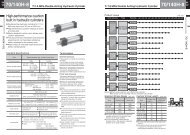70/140H-8 Series (2310KB) - TAIYO
70/140H-8 Series (2310KB) - TAIYO
70/140H-8 Series (2310KB) - TAIYO
You also want an ePaper? Increase the reach of your titles
YUMPU automatically turns print PDFs into web optimized ePapers that Google loves.
Magnetic proximity type (with contact)<br />
Maximum energy absorbed of cylinder cushion<br />
Selection<br />
materials 26<br />
The conditions of absorbed energy allowable for the cylinder cushion can be obtained from the formula below.<br />
Inertia energy of load at<br />
the inrush into cushion<br />
E1<br />
+<br />
Energy generated by the external force applied<br />
to the cylinder at the inrush into cushion q<br />
The procedures to find each item above are shown below.<br />
E2<br />
Maximum energy absorbed of<br />
the cylinder cushion<br />
Find the inertia energy of load at the inrush into cushion, E1.<br />
In the case of linear movement:<br />
E1 = MV 2 /2 (J) M : load weight (kg)<br />
V : load speed at the inrush into cushion (m/s)<br />
In the case of rotation movement:<br />
E1 = !ω 2 /2 (J) !: inertia moment of load (kg • m 2 )<br />
ω : angular velocity of load at the inrush into cushion (rad/s)<br />
Notes: If the cylinder speed is less than 0.08 m/s (80 mm/s), the cushioning effect is weakened.<br />
Even if the cylinder speed is less than 0.08 m/s (80 mm/s), suppose it is 0.08 m/s to find the E1.<br />
In the case of rotation movement, even when the cylinder speed is 0.08 m/s or lower, similarly<br />
suppose it is 0.08 m/s, and calculate the angular velocity ω to find the E1.<br />
Find the energy generated by the external force applied to the cylinder at the inrush into cushion, E2.<br />
The forces acting in the direction of the cylinder axis at the inrush into cushion are shown below.<br />
• The force applied to the cylinder by the gravity of load<br />
• The force applied by other cylinders<br />
• The force applied to the cylinder by springs<br />
Find the external force F, which is applied to the cylinder at the inrush into cushion, and the energy E2 by using<br />
the “Chart of conversion of external force into energy at the inrush into cushion of <strong>70</strong>/<strong>140H</strong>-8”.<br />
In case that such an external force is not applied, the following condition is satisfied: E2 = 0.<br />
For the selection of cushion, suppose that the frictional resistance of load is 0.<br />
Find the maximum energy absorbed of the cylinder cushion, Et.<br />
Find it with the corresponding chart of the “Maximum energy absorbed”.<br />
Remember that the maximum energy absorbed of the cylinder moving forward (the ejected direction of the piston rod from the<br />
cylinder) and that of the cylinder moving backward are identical.<br />
Ensure that E1 + E2 is same as the maximum energy absorbed Et, or smaller.<br />
If the following condition is satisfied, the cylinder is applicable: E1 + E2 q Et.<br />
If the following condition is satisfied, the cylinder is inapplicable: E1 + E2 Q Et.<br />
In such a case, perform the steps below, and then, select again.<br />
• Decrease the inertia force of load.<br />
• Decrease the external force applied to the cylinder.<br />
• Lower the set pressure.<br />
• Widen the cylinder bore.<br />
• Install a shock absorber.<br />
When installing a shock absorber, refer to the “<strong>TAIYO</strong> Shock absorber general catalogue”.<br />
DO NOT use the cylinder cushion together with a shock absorber. Otherwise, the inertia force of load<br />
may be applied to either of them due to the difference of cushioning characteristics.<br />
CAUTION<br />
Be sure to use cylinders within the range of the maximum energy absorbed of the cylinder cushion.<br />
Otherwise, the cylinder or the peripheral devices may be damaged, leading to serious accidents.<br />
↓<br />
↓<br />
↓<br />
Et<br />
Selection materials




